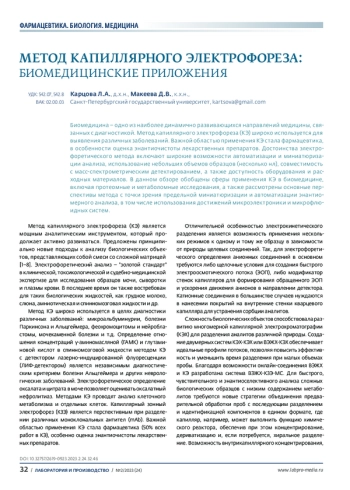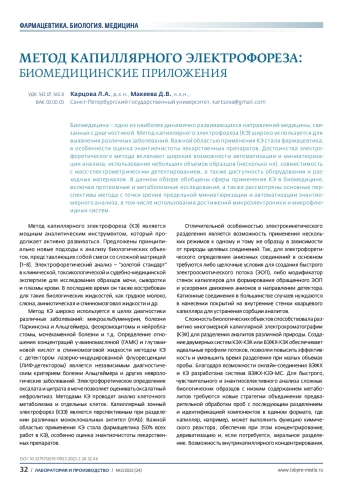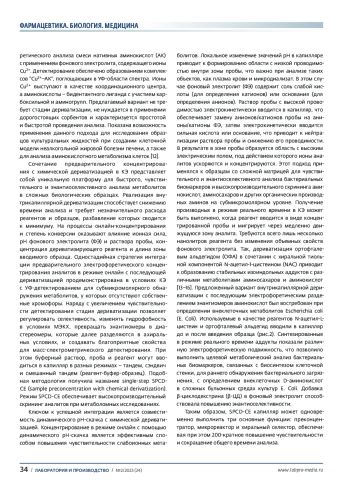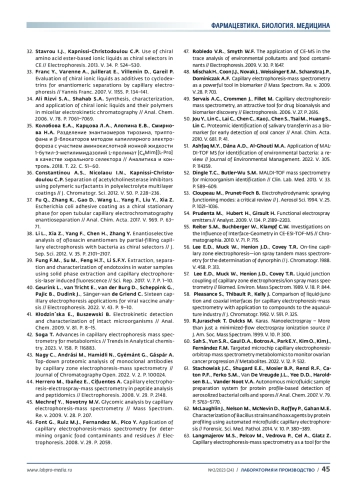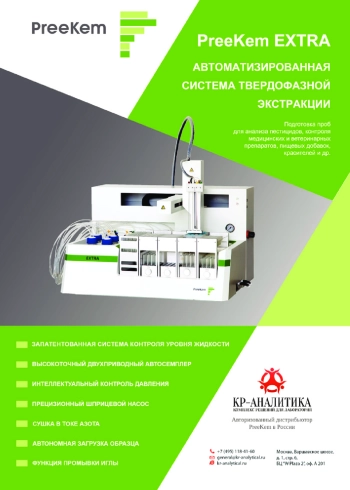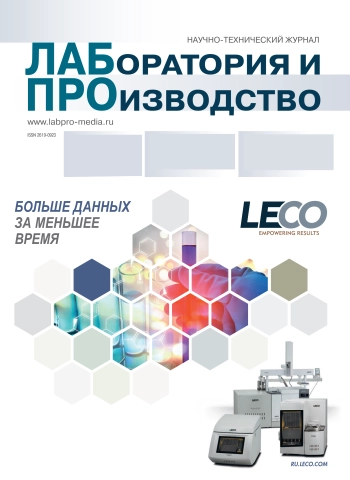1. Morani M., Duc Mai T., Krupova Z., van Niel G., Defrenaix P., Taverna M. Recent electrokinetic strategies for isolation, enrichment and separation of extracellular vesicles // Trends in Analytical Chemistry. 2021. V. 135. P. 116179.
2. Terry M. Phillips. Clinical Applications of Capillary Electrophoresis Methods and Protocols-Springer. New York Humana Press. 2019.
3. Seyfinejad B., Jouyban A. Capillary electrophoresis-mass spectrometry in pharmaceutical and biomedical analyses // Journal of Pharmaceutical and Biomedical Analysis. 2022. V. 221. P. 115059.
4. Kartsova L.A., Makeeva D.V., Bessonova E.A. Current status of capillary electrophoresis // Journal of Analytical Chemistry. 2020. V. 75. N. 12. P. 1497–1513.
5. Ou X., Chen P., Huang X., Li S., Liu B-F. Microfluidic chip electrophoresis for biochemical analysis // J. Sep. Sci. 2020. V. 43. P. 258–270.
6. Soga T. Advances in capillary electrophoresis mass spectrometry for metabolomics // Trends in Analytical Chemistry. 2023. V. 158. P. 116883.
7. Kartsova L.A., Makeeva D.V., Kravchenko A.V., Moskvichev D.O., Polikarpova D.A. Capillary electrophoresis as a powerful tool for the analyses of bacterial samples // Trends in Analytical Chemistry. 2021. V. 134. P. 116110.
8. Lothert K., Eilts F., Wolff M.W. Quantification methods for viruses and virus-like particles applied in biopharmaceutical production processes // Expert Review of Vaccines. 2022. V. 21. P. 1029–1044.
9. Kravchenko A., Kolobova E., Kartsova L. Multifunction covalent coatings for separation of amino acids, biogenic amines, steroid hormones, and ketoprofen enantiomers by capillary electrophoresis and capillary electrochromatography // Sep. Sci. plus. 2020. V. 3. P. 102–111.
10. Kravchenko A.V., Kolobova E.A., Kechin A.A., Kartsova L.A. Development of a capillary electrophoretic method for determination of ketorolac enantiomers in human plasma using cationic β-cyclodextrin derivative as a chiral selector // J. Sep. Sci. in press.
11. Makeeva D., Polikarpova D., Demyanova E., Roshchina E., Vakhitov T., Kartsova L. Determination of native amino acids and lactic acid in Lactobacillus helveticus culture media by capillary electrophoresis using Cu2 + and β-cyclodextrins as additives // J. Chrom. B. 2020. V. 1156. P. 122304.
12. Makeeva D., Sall T., Moskvichev D., Kartsova L., Sitkin S., Vakhitov T. CE with Cu2 + ions and 2-hydroxypropyl- β-cyclodextrin additives for the investigation of amino acids composition of the culture medium in a cellular model of nonalcoholic fatty liver disease // J. Pharm. Biomed. Anal. 2022. V. 213. P. 114663.
13. Ptolemy A.S., Tran L., Britz-McKibbin P. Single-step enantioselective amino acid flux analysis by capillary electrophoresis using on-line sample preconcentration with chemical derivatization // Anal. Biochem. 2006. № 354. P. 192–204.
14. Kartsova L.A., Moskvichev D.O. In-capillary chiral derivatization of amino acids // J. of Anal. Chemistry. 2022. V. 77. P. 618–624.
15. Oliveira R., Simionato V.A.C., Cass B. Enantioselectivity effects in clinical metabolomics and lipidomics // Molecules. 2021. V. 26. P. 5231.
16. Tanwar S., Bhushan R. Enantioresolution of amino acids: a decade’s perspective, prospects and challenges // Chromatographia. 2015. V. 78. P. 1113–1134.
17. Bernardo-Bermejo S., Sánchez-López E., Castro-Puyana M., Marina M.L. Chiral capillary electrophoresis // TrAC – Trends Anal. Chem. 2020. V. 124.
18. Fanali S., Chankvetadze B. Some thoughts about enantioseparations in capillary electrophoresis // Electrophoresis. 2019. V. 40. P. 2420–2437.
19. Saz J.M., Marina M.L. Recent advances on the use of cyclodextrins in the chiral analysis of drugs by capillary electrophoresis // J. Chromatogr. A. 2016. V. 1467. P. 79–94.
20. Řezanka P., Navrátilová K., Řezanka M., Král V., Sýkora D. Application of cyclodextrins in chiral capillary electrophoresis // Electrophoresis. 2014. V. 35. P. 2701–2721.
21. Yu R.B., Quirino J.P. Chiral separation using cyclodextrins as mobile phase additives in open-tubular liquid chromatography with a pseudophase coating // J. Sep. Sci. 2022. V. 45. P. 1195–1201.
22. Peluso P., Chankvetadze B. Native and substituted cyclodextrins as chiral selectors for capillary electrophoresis enantioseparations: structures, features, application, and molecular modeling // Electrophoresis. 2021. V. 42. P. 1676–1708.
23. De Boer T., De Zeeuw R.A., De Jong G.J., Ensing K. Recent innovations in the use of charged cyclodextrins in capillary electrophoresis for chiral separations in pharmaceutical analysis // Electrophoresis. 2000. V. 21. P. 3220–3239.
24. Dai Y., Wang S., Zhou J., Liu Y., Sun D., Tang J., Tan W. gCationic cyclodextrin as versatile chiral selector for enantiomeric separation in capillary electrophoresis // J. Chromatogr. A. 2012. V. 1246. P. 98–102.
25. Li A., Xue S., Ren S., Xu Y., Zhang Q. Hydrophobic deep eutectic solvents as pseudo-stationary phases in capillary electrokinetic chromatography // Analytica Chimica Acta. 2022. V. 121. P. 339936.
26. Hu W., Hong T., Gao X., Ji Y. Applications of nanoparticlemodified stationary phases in capillary electrochromatography // Trends in Analytical Chemistry. 2014. V. 61. P. 29–39.
27. Chen J.L., Hsieh K.H. Nanochitosan crosslinked with polyacrylamide as the chiral stationary phase for open-tubular capillary electrochromatography // Electrophoresis. 2011. V. 32. P. 398–407.
28. Wang D., Song X., Duan Y., Xu L., Zhou J., Duan H. Preparation and characterization of a polystyrene/bovine serum albumin nanoparticle-coated capillary for chiral separation using open-tubular capillary electrochromatography // Electrophoresis. 2013. V. 34. P. 1339–1342.
29. Fanali S., Rudaz S., Veuthey J.L., Desiderio C. Use of vancomycin silica stationary phase in packed capillary electrochromatography // J. Chromatogr. A. 2001. V. 919. P. 195.
30. Zhang Q. Ionic liquids in capillary electrophoresis for enantioseparation // TrAC – Trends Anal. Chem. 2018. V. 100. P. 145– 154.
31. Zhang J., Du Y., Zhang Q., Lei Y. Evaluation of vancomycinbased synergistic system with amino acid ester chiral ionic liquids as additives for enantioseparation of non-steroidal anti-inflamatory drugs by capillary electrophoresis // Talanta. 2014. V. 119. P. 193.
32. Stavrou I.J., Kapnissi-Christodoulou C.P. Use of chiral amino acid ester-based ionic liquids as chiral selectors in CE // Electrophoresis. 2013. V. 34. P. 524–530.
33. Franc Y., Varenne A., Juillerat E., Villemin D., Gareil P. Evaluation of chiral ionic liquids as additives to cyclodextrins for enantiomeric separations by capillary electrophoresis // Yannis Franc. 2007. V. 1155. P. 134–141.
34. Ali Rizvi S.A., Shahab S.A. Synthesis, characterization, and application of chiral ionic liquids and their polymers in micellar electrokinetic chromatography // Anal. Chem. 2006. V. 78. P. 7061–7069.
35. Колобова Е.А., Карцова Л.А., Алопина Е.В., Смирнова Н.А. Разделение энантиомеров тирозина, триптофана и β-блокаторов методом капиллярного электро- фореза с участием аминокислотной ионной жидкости 1-бутил-3-метилимидазолий L-пролинат [C4MIm][L-Pro] в качестве хирального селектора // Аналитика и контроль. 2018. T. 22. C. 51–60.
36. Constantinou A.S., Nicolaou I.N., Kapnissi-Christodoulou C.P. Separation of acetylcholinesterase inhibitors using polymeric surfactants in polyelectrolyte multilayer coatings // J. Chromatogr. Sci. 2012. V. 50. P. 228–236.
37. Fu Q., Zhang K., Gao D., Wang L., Yang F., Liu Y., Xia Z. Escherichia coli adhesive coating as a chiral stationary phase for open tubular capillary electrochromatography enantioseparation // Anal. Chim. Acta. 2017. V. 969. P. 63– 71.
38. Li L., Xia Z., Yang F., Chen H., Zhang Y. Enantioselective analysis of ofloxacin enantiomers by partial-filling capillary electrophoresis with bacteria as chiral selectors // J. Sep. Sci. 2012. V. 35. P. 2101–2107.
39. Fung F.M., Su M., Feng H.T., Li S.F.Y. Extraction, separation and characterization of endotoxins in water samples using solid phase extraction and capillary electrophoresis- laser induced fluorescence // Sci. Rep. 2017. V. 7. P. 1–10.
40. Geurink L., van Tricht E., van der Burg D., Scheppink G., Pajic B., Dudink J., Sänger-van de Griend C. Sixteen capillary electrophoresis applications for viral vaccine analysis // Electrophoresis. 2022. V. 43. P. 9–10.
41. Kłodzin´ska E., Buszewski B. Electrokinetic detection and characterization of intact microorganisms // Anal. Chem. 2009. V. 81. P. 8–15.
42. Soga T. Advances in capillary electrophoresis mass spectrometry for metabolomics // Trends in Analytical chemistry. 2023. V. 158. P. 116883.
43. Nagy C., Andrási M., Hamidli N., Gyémánt G., Gáspár A. Top-down proteomic analysis of monoclonal antibodies by capillary zone electrophoresis-mass spectrometry // Journal of Chromatography Open. 2022. V. 2. P. 100024.
44. Herrero M., Ibañez E., Cifuentes A. Capillary electrophoresis- electrospray-mass spectrometry in peptide analysis and peptidomics // Electrophoresis. 2008. V. 29. P. 2148.
45. Mechref Y., Novotny M.V. Glycomic analysis by capillary electrophoresis-mass spectrometry // Mass Spectrom. Re. v. 2009. V. 28. P. 207.
46. Font G., Ruiz M.J., Fernandez M., Pico Y. Application of capillary electrophoresis-mass spectrometry for determining organic food contaminants and residues // Electrophoresis. 2008. V. 29. P. 2059.
47. Robledo V.R., Smyth W.F. The application of CE-MS in the trace analysis of environmental pollutants and food contaminants // Electrophoresis. 2009. V. 30. P. 1647.
48. Mischak H., Coon J.J., Novak J., Weissinger E.M., Schanstra J.P., Dominiczak A.F. Capillary electrophoresis-mass spectrometry as a powerful tool in biomarker // Mass Spectrom. Re. v. 2009. V. 28. P. 703.
49. Servais A.C., Crommen J., Fillet M. Capillary electrophoresismass spectrometry, an attractive tool for drug bioanalysis and biomarker discovery // Electrophoresis. 2006. V. 27. P. 2616.
50. Jou Y., Lin C., Lai C., Chen C., Kao J., Chen S., Tsai M., Huang S., Lin C. Proteomic identification of salivary transferrin as a biomarker for early detection of oral cancer // Anal. Chim. Acta. 2010. V. 681. P. 41.
